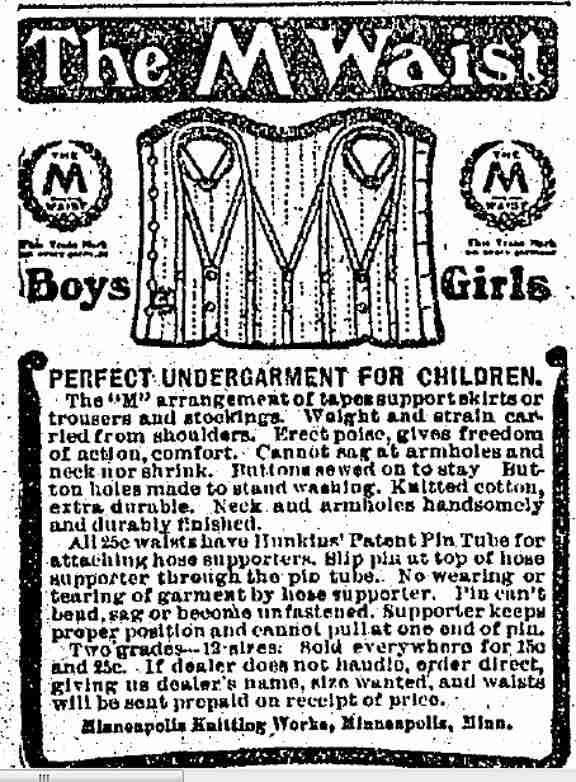
Minneapolis Knitting Works: M (Under) Waist (United States, 1904-05)

Figure 1.-- We note a newspaper advertisement for the well-known M Waist (manufactured by Minneapolis Knitting Works). An advertisement for the well-known M Waist (manufactured by Minneapolis Knitting Works) appeared widely in American newspapers in 1904-05. One example shows up in the Moulton Weekly Tribune (in Iowa) in 1904 (June 3, 1904, page 3). The text is unusually explicit about the particular features of this underwaist, which was a unisex garment
worn by both boys and girls from the age of 2 to 13 (or possibly 14).
|
|
We note a newspaper advertisement for the well-known M Waist (manufactured by Minneapolis Knitting Works). An advertisement for the well-known M Waist (manufactured by Minneapolis Knitting Works) appeared widely in American newspapers in 1904-05. One example shows up in the Moulton Weekly Tribune (in Iowa) in 1904 (June 3, 1904, page 3). The text is unusually explicit about the particular features of this underwaist, which was a unisex garment
worn by both boys and girls from the age of 2 to 13 (or possibly 14). A diagram in the ad shows exactly where the buttons and garter tabs were placed and how the reinforcement straps function.
Newspaper Advertisement
We note a newspaper advertisement for the well-known M Waist (manufactured by Minneapolis Knitting Works). An advertisement for the well-known M Waist (manufactured by Minneapolis Knitting Works) appeared widely in American newspapers in 1904-05. One example shows up in the Moulton Weekly Tribune (in Iowa) in 1904 (June 3, 1904, page 3).
The company at the time was one of the principal manugacturers of underwear in the United states. The Minneapolis Kinitting Works after World War I developed new styles of underwar for children. An ad in Parents' Magazine read, "Minneapolis "M" garments
are universally accepted as the correct underdressing in juvenile styles. The fashionable French Type (short trunk) garments illustrated above are made for both boys and girls in all popular fabrics." The advertisement appeared in Parents Magazine during September, 1930, p. 45. This Minneapolis Knitting Works advertisement, timed obviously for mothers who were shopping for their school children at the beginning of the school year, advertises principally waists suits. The ad shows a wide range of underwear garments.
Underwaists were another type of support garment. Underwaists (sometimes called panty-waists) were worn by younger boys and girls to support additional underwear (such as bloomers or panties) or outer clothing (such as trousers or skirts). These bodices tended to be worn by boys only until about age 10, although some models came in ages for boys as old as 12. Some models were specifically for girls and others for boys, but the great majority of styles could be worn by both boys and girls. They tended to be made of elastic knitted fabric (and therefore rather form-fitting) or of cambric material and a bit looser. They nearly always were equipped with reinforcement straps, waist buttons, and garter tabs for attaching hose supporters. The popularity of underwaists declined in the later 1930s and early 1940s although they were still available, usually in the preferred knitted style, up until about 1945. When long stockings stopped being worn by school children, the main function of the underwaist ceased to exist.
Features
The text is unusually explicit about the particular features of this underwaist, which was a unisex garment
worn by both boys and girls from the age of 2 to 13 (or possibly 14). A diagram in the ad shows exactly where the buttons and garter tabs were placed and how the reinforcement straps function.
Text
Here is the ad copy text, "The M Waist for Boys and Girls. Perfect Undergarment for Children into their Teen Years. The 'M' arrangement of tapes support skirts or trousers and stockings. Weight and strain carried from
shoulders. Erect poise, gives freedom of action,comfort. Cannot sag at armholes and neck nor shrink. Buttons sewed on to stay. Button holes made to stand washing. Knitted cotton, extra durable. Neck and armholes handsomely and durably finished. All 25 cent waists have Hunkins' Patent Pin Tub for attaching hose supporters. Slip pin at top of hose supporter through the pin tube. No wearing or tearing of garment by hose supporter. Pin can't bend, sag or become unfastened. Supporter keeps proper position and cannot pull at one end of pin. Two grades--12 sizes [2 to 14-14]. Sold everywhere for 15 cents and 25 cents. If dealer does not handle, order direct, giving us dealer's name, size wanted, and waists will be sent prepaid on receipt of price. Minneapolis Knitting Works, Minneapolis, Minn."
There was a technical diagram of the waist which opened up and flattened out at the top of the ad here. It
shows exactly where the buttons, straps, and garter tabs are located (although you can't see the actual pin tubes). But the pin tubes are described in the text below with the mention of Hunkins. This describes Hunkins's invention of the pin tube and the various alternative methods of attachment which were used on other waits.
HBC

Navigate the Boys' Historical Clothing catalog/magazine pages:
[Return to the Main 1904 catalog page]
[Return to the Main 1900s catalog pagepage]
[Main photo/publishing page]
[Store catalogs]
[Fashion magazines]
Navigate the Boys' Historical Clothing Web Site:
[Introduction]
[Activities]
[Biographies]
[Chronology]
[Cloth and textiles]
[Clothing styles]
[Countries]
[Topics]
[Bibliographies]
[Contributions]
[FAQs]
[Glossaries]
[Images]
[Links]
[Registration]
[Tools]
[Boys' Clothing Home]
Navigate the Boys' Historical Clothing Web Site:
[Sailor hats]
[Sailor suits]
[Buster Brown suits]
[Rugby suits]
[Norfolk suits]
[Eton suits]
[Rompers]
[Tunics]
[Smocks]
[Pinafores]
[Long stockings]
[Underwear]
Created: 9:06 AM 1/13/2010
Last updated: 1:06 AM 1/15/2010



